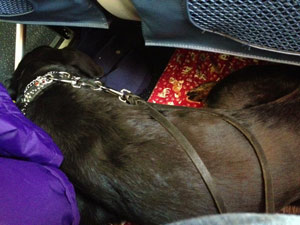Written by Colt Rosensweig
The distinction between a service dog and an emotional support animal seems very clear-cut to members of the service dog community. However, given recent events, including an incident where an emotional support dog mauled a passenger on a Delta flight, it has become quite clear that this distinction is not as obvious to the general public.
Let’s get therapy dogs out of the way first.
“Therapy dog” is a term often applied to service dogs or ESAs by various kinds of people, most notably journalists who lack research skills. These terms are not interchangeable, and to call a service dog or emotional support animal a therapy dog/animal is quite incorrect. Therapy dogs are pets who are invited to places dogs normally may not be allowed, such as hospitals, nursing homes, schools, or libraries. Their handlers have no special rights to take them anywhere that is not pet-friendly. They must be invited. Certification and registration is required by some therapy dog organizations but not all. Usually therapy dogs must pass some test of their temperament and obedience before beginning their work. Therapy dogs help a multitude of people who are not their owner(s).

Service dogs (SDs) and emotional support animals (ESAs) help their owners/handlers, not, as a general rule, other people. Owners of ESAs and handlers of SDs must be disabled. Usually the person will have a doctor’s support for use of a dog or other animal to help with their disability as well. Both SDs and ESAs must be permitted in no-pet housing, and on airplanes. (Why untrained pets are legally permitted to fly uncontained in the cabin of an airplane is a question I have, as of yet, been unable to answer using logic or reason.)
This is about where the similarity ends.
The major difference between a SD and an ESA is training. A service dog, in order to be a service dog, must be individually trained to perform work or do tasks to mitigate the handler’s disability. An ESA is not required to have any training whatsoever. They provide comfort to owners with psychiatric disabilities simply by being themselves, and acting like any well-loved pet. And ESAs are pets. They’re pets whose owners have a few specific, special rights which I have already mentioned, but still pets. Service dogs, under the law, are considered medical equipment. This is why they are permitted to go with their handlers anywhere the general public is allowed.

Service dogs, usually from puppyhood, have undergone extensive socialization, exposure, and training so that they are able to handle any number of highly stressful situations (like flying on a plane) while remaining calm and composed. They are accustomed to being out in public, to crowds, to loud and sudden noises, and all manner of strange things your average pet would never have to deal with. If a service dog is unable to handle the stress of working in public—and make no mistake, no matter how calm a dog is, service dog work is inherently stressful—they are either washed out completely, or used part-time, in specific circumstances they are able to handle in a professional manner.
While some conscientious owners may train their ESAs, no training of any sort is actually required.
This is why they, like all other pets, are not permitted in places like restaurants, grocery stores, movie theatres, or other such places. They generally don’t have the temperament or training required to handle it. They also may not be dogs. Many ESAs are dogs, of course, but the “A” in ESA means that any species can theoretically qualify as a person’s emotional support animal. This is how people gaming the system have gotten animals like turkeys, pigs, and snakes onto airplanes (legally, mind you!). Only handlers of service dogs or miniature horses have general public access right with their animals; the sheer variety of animals that can function as ESAs is another reason their owners don’t have the right to be accompanied by them in public.
The Americans with Disabilities Act could not be clearer about the difference between SDs and ESAs.
“Service animals are working animals, not pets,” the Department of Justice states. “The work or task a dog has been trained to provide must be directly related to the person’s disability. Dogs whose sole function is to provide comfort or emotional support do not qualify as service animals under the ADA.” While businesses may not inquire into a person’s specific disability, they can legally ask if the dog is a service dog and what job the dog performs. And if the person answers something like “comfort” or “emotional support,” he or she is done. The business is obligated, for the safety of the public, the pet, and service dog teams, not to allow that person to bring their dog in with them. The St. Louis Zoo recently did an excellent job of enforcing the law, refusing to permit a woman with her emotional support dog to enter the zoo with it. Unfortunately, news stories misidentified the dog as a SD, despite the woman answering the two questions by denying the dog was a service dog, and stating that its purpose was to provide emotional support. Can’t get much clearer than that!
I do not take the job emotional support animals do lightly.
Put simply, they are a crucial way to keep many people with psychiatric disabilities from taking their own lives. That is not a trivial job. It is crucial that people in need of ESAs are able to keep them, regardless of where they live. People without disabilities who buy fake ESA registration or certification—just as fake and just as useless as SD registration and certification—are endangering that right, and I find their actions reprehensible. But ESAs are, most emphatically, not comparable to service dogs when it comes to public access. They just cannot meet the behavioral standards required of a service dog in public.
These differences cannot be overstated—especially in the case of psychiatric service dogs and ESAs. Many people use these terms interchangeably, and this does a huge disservice to handlers of psychiatric service dogs. Any handler who identifies their dog as a “psych dog,” for example, is forced to jump through extra hoops during air travel. The Air Carrier Access Act, which dictates the rights of disabled people in air travel, treats psychiatric service dogs the same as untrained ESAs, which, frankly, is unacceptably discriminatory. Those who identify their dogs as psychiatric SDs must provide a letter, less than one year old, written by a mental health professional stating that their dog is necessary because of a disability. Owners of ESAs are required to produce the same letter. Meanwhile, every other kind of service dog handler can go through security and board in the same manner as non-disabled travelers. Is it any wonder handlers are reluctant to “out” their SDs as psych dogs? This is just one added layer of stigma, highly unhelpful to those dealing with a psychiatric disability.
Psychiatric SDs are just like any other service dogs.
Their handlers are disabled, only that disability is often invisible to the general public. Psychiatric SDs are required to conform to the same high behavioral standards as other SDs, and that includes, most emphatically, doing work or tasks to mitigate the handler’s disability. These tasks can run the gamut, from performing deep pressure therapy to leading a handler to an exit or quiet place to sit when they dissociate. ESAs are not trained to behave in public or to do tasks, and as such, are not even remotely comparable to psychiatric service dogs.
Insisting on the distinctions between service dogs and ESAs is not some nitpicky exercise in semantics. Knowing the difference and enforcing the appropriate regulations regarding each type of animal is crucial to keeping service dog teams, and the public, safe.







